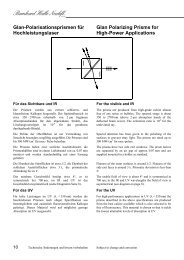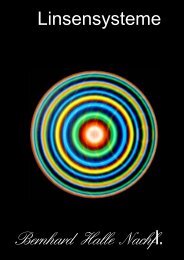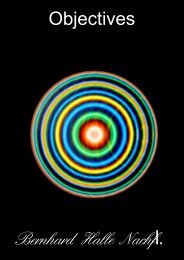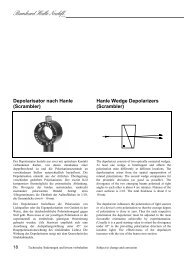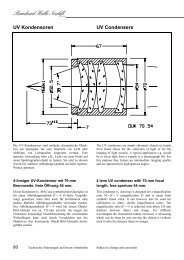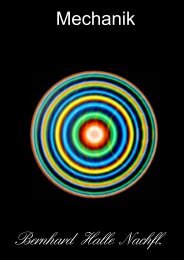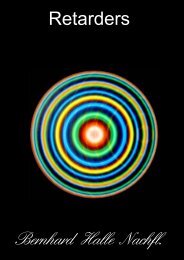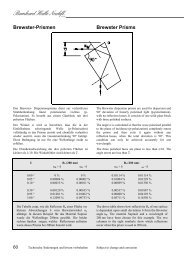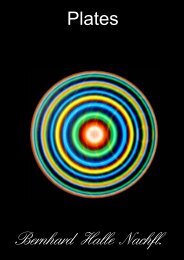Wollaston- und Rochon - Bernhard Halle
Wollaston- und Rochon - Bernhard Halle
Wollaston- und Rochon - Bernhard Halle
Sie wollen auch ein ePaper? Erhöhen Sie die Reichweite Ihrer Titel.
YUMPU macht aus Druck-PDFs automatisch weboptimierte ePaper, die Google liebt.
Standardwellenlängen für low order Platten aus MgF2<br />
Standard wavelengths for low order MgF2 retarders<br />
532 nm 633 nm 1064 nm 3500 nm 4750 nm 6000 nm<br />
Sonderanfertigungen: Available on special order:<br />
Mehrpreis für Sonderwellenlängen:<br />
freie Öffnung 9,5 mm <strong>und</strong> 14,5 mm RLM 0.1<br />
freie Öffnung 19,5 mm <strong>und</strong> 24,5 mm RLM 0.2<br />
Entspiegelung auf Anfrage<br />
Platten mit anderen Formaten auf Anfrage<br />
Verzögerungsplatten aus MgF2:<br />
zero order<br />
Die Verzögerer bestehen aus zwei mit gekreuzten<br />
Kristallachsen zusammengesetzten Einzelplatten. Die<br />
Funktionsweise ist identisch mit dem der zero order Platten<br />
aus Quarzkristall (Seite 24). Die Vorteile von MgF2 liegen<br />
in dem weiteren Transmissionsbereich von 120 nm – 7µm<br />
sowie der fehlenden optischen Aktivität, welche bei Quarz<br />
in Anwendungen mit hohen Polarisationsanforderungen<br />
störend wirken kann.<br />
Die Dicke der Einzelplatte liegt bei 0,8 mm (Gesamtdicke<br />
ca. 1,6 mm). Die Wellenfrontdeformation beträgt λ/10 (bei<br />
λ = 550 nm) <strong>und</strong> der Keilfehler ist kleiner als 2’’. Die<br />
Genauigkeit des Gangunterschieds beträgt ±2 nm.<br />
Der Spektralbereich, über den eine einzelne zero-order-<br />
Platte verwendet werden kann, ist wesentlich kleiner als der<br />
Transmissionsbereich <strong>und</strong> hängt von der geforderten<br />
Genauigkeit der Verzögerung ab. Wie bei den zero order<br />
Platten aus Quarz ist der Fehler des Gangunterschieds<br />
kleiner als die Fertigungstoleranz, wenn die Wellenlänge<br />
um nicht mehr als ±4 nm (λ/2-Platten) bzw. ±8 nm (λ/4-<br />
Platten) von der Sollwellenlänge abweicht. In vielen Fällen<br />
können auch Abweichungen deutlich oberhalb unserer<br />
Fertigungstoleranz hingenommen werden, wodurch sich ein<br />
entsprechen breiterer spektraler Anwendungsbereich ergibt.<br />
Eine Abschätzung der Abweichung ∆R vom Sollwert R der<br />
Verzögerung (jeweils in nm) aufgr<strong>und</strong> von<br />
Temperaturänderung um ∆T (in K) oder Neigung um ∆φ<br />
(in Grad) ist wie folgt möglich:<br />
∆R ≈ -(4·10 -5 K -1 )·R·∆T<br />
∆R ≈ ±(1,5 nm/Grad²)·∆φ²<br />
Für eine λ/2-Platte bei 633 nm liegen die Abweichungen<br />
bei Temperaturänderungen um bis zu ±160 K oder Kippwinkeln<br />
von bis zu ±1,2° unterhalb der Fertigungstoleranz.<br />
non-standard wavelengths have a surcharge:<br />
clear aperture 9.5 mm and 14.5 mm RLM 0.1<br />
clear aperture 19.5 mm and 24.5 mm RLM 0.2<br />
Antireflection coating on request<br />
other dimensions on request<br />
MgF2 Retarders: zero order<br />
The retarders consist of two single plates which are<br />
assembled their optical crystal axes in crossed position. The<br />
working principle is identical with that of the zero order<br />
retarders made from crystal quartz (page 24). The<br />
advantages of MgF2 are its broader transmission range of<br />
120 nm – 7µm and the lack of optical activity which can be<br />
troublesome in applications which require a high degree of<br />
polarization.<br />
The thickness of each plate is about 0.8 mm (total thickness<br />
approx. 1.6 mm). The wavefront distortion is λ/10 (at<br />
λ = 550 nm) and the wedge error is smaller than 2’’. The<br />
accuracy of the path difference is ± 2 nm.<br />
The usable spectral range for a single zero-order plate is<br />
much smaller than the transmission range and depends on<br />
the required accuracy of the retardation. As for the zero<br />
order retarders made of quartz crystal the error of the path<br />
differnce is smaller than the production tolerance if the<br />
wavelengths deviates by less then 4 nm (λ/2 plates) or<br />
±8 nm (λ/4 plates) from the design wavelength. A deviation<br />
considerably larger than the production tolerance is<br />
acceptable in many applications resulting in a<br />
correspondingly broader usable spectral range.<br />
The deviation ∆R of the path difference from the nominal<br />
value R (both in nm) due to a temperature change by ∆T (in<br />
K) or due to tilt by ∆φ (in degrees) can be estimated as<br />
follows:<br />
∆R ≈ -(4·10 -5 K -1 )·R·∆T<br />
∆R ≈ ±(1.5 nm/deg²)·∆φ²<br />
For λ/2 plate at 633 nm the deviations will be smaller than<br />
the production tolerance for a temperature change up to<br />
±160 K order for tilt angles up to ±1.2°.<br />
Technische Änderungen <strong>und</strong> Irrtum vorbehalten Subject to change and correction 27



